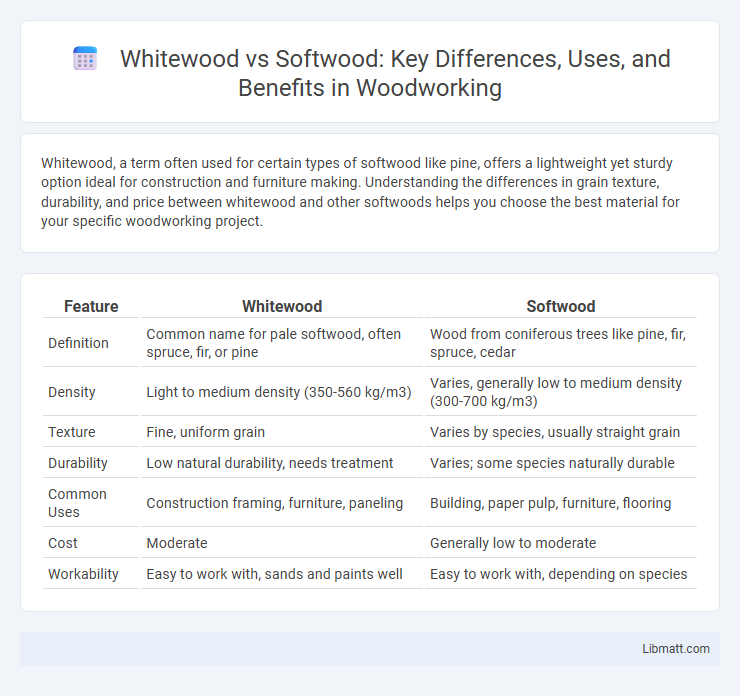Whitewood, a term often used for certain types of softwood like pine, offers a lightweight yet sturdy option ideal for construction and furniture making. Understanding the differences in grain texture, durability, and price between whitewood and other softwoods helps you choose the best material for your specific woodworking project.
Table of Comparison
| Feature | Whitewood | Softwood |
|---|---|---|
| Definition | Common name for pale softwood, often spruce, fir, or pine | Wood from coniferous trees like pine, fir, spruce, cedar |
| Density | Light to medium density (350-560 kg/m3) | Varies, generally low to medium density (300-700 kg/m3) |
| Texture | Fine, uniform grain | Varies by species, usually straight grain |
| Durability | Low natural durability, needs treatment | Varies; some species naturally durable |
| Common Uses | Construction framing, furniture, paneling | Building, paper pulp, furniture, flooring |
| Cost | Moderate | Generally low to moderate |
| Workability | Easy to work with, sands and paints well | Easy to work with, depending on species |
Introduction to Whitewood and Softwood
Whitewood refers to light-colored softwoods commonly used in construction and furniture, primarily including species like pine, spruce, and fir. Softwood comes from coniferous trees and typically features faster growth rates and lower density compared to hardwood, making it cost-effective and versatile for various applications. Understanding the differences in grain, durability, and workability helps you choose between whitewood and other softwoods for your specific project needs.
Defining Whitewood: Characteristics and Types
Whitewood refers to a category of softwoods primarily derived from coniferous trees such as pine, spruce, and fir, valued for their light color and fine grain. Characterized by its workability, relative softness, and affordability, whitewood is widely used in construction, furniture, and millwork applications. Common types include Eastern white pine, Norway spruce, and Douglas fir, each offering unique strength and durability properties suited for various projects.
What is Softwood? Key Features and Varieties
Softwood comes from coniferous trees like pine, fir, and cedar, which have needle-like leaves and grow faster than hardwoods, making them more sustainable and affordable. Key features of softwood include lighter weight, lower density, and easier workability, ideal for construction, furniture, and paper products. Whitewood, often sourced from species like spruce or pine, is a popular softwood variety known for its pale color and versatility in applications such as framing and interior finishing.
Botanical Differences Between Whitewood and Softwood
Whitewood typically refers to timber from deciduous broadleaf trees like maple or birch, whereas softwood comes from coniferous trees such as pine, spruce, or fir. The botanical difference lies in their vascular structures; softwoods have simple tracheids for water conduction, while hardwoods (whitewoods) feature complex vessels and fibers. Understanding these botanical distinctions can help you choose the right wood type for specific construction or woodworking projects.
Strength and Durability Comparison
Whitewood, commonly sourced from spruce or fir trees, generally exhibits moderate strength and durability, making it suitable for interior construction and furniture where heavy load-bearing is minimal. Softwood varieties differ widely in strength; for example, pine offers higher resistance and durability compared to whitewood, often making it preferable for structural applications. When selecting wood for projects requiring long-lasting support, consider species-specific properties, such as density and grain tightness, which significantly influence overall durability and load capacity.
Common Uses: Whitewood vs. Softwood
Whitewood, often a type of softwood sourced from trees like pine or spruce, is widely used in furniture making, cabinetry, and interior trim due to its light color and smooth grain. Softwood, which includes species beyond whitewood such as fir, cedar, and redwood, finds extensive application in construction framing, roofing, and outdoor structures because of its strength and durability. Both whitewood and other softwoods are favored in woodworking projects, but whitewood's aesthetic appeal makes it ideal for visible and decorative purposes.
Workability and Finishing Properties
Whitewood, often derived from species like pine or spruce, offers excellent workability due to its soft texture and straight grain, making it easy to cut, shape, and sand. Softwood generally exhibits good finishing properties, absorbing stains and paints effectively, but whitewood's lighter color provides a better base for clear finishes and bright stains. Its uniform surface ensures smooth application and durability in the final finish, ideal for cabinetry, furniture, and interior trim.
Cost and Availability in the Market
Whitewood, often derived from species like pine or fir, is generally more affordable due to its rapid growth and widespread availability, making it a cost-effective option for construction and furniture projects. Softwood, encompassing whitewood and other species like cedar and spruce, varies in price but is typically less expensive than hardwoods, with market availability depending on regional forestry practices. Your choice between whitewood and other softwoods should consider both budget constraints and local supply to ensure project feasibility and cost efficiency.
Environmental Impact and Sustainability
Whitewood, often sourced from fast-growing species like pine and spruce, generally has a lower environmental impact due to its rapid renewability and efficient carbon sequestration during growth. Softwood varieties, while similar, vary in sustainability depending on forest management practices, with certified sustainably harvested softwood minimizing ecological damage and promoting biodiversity. You can reduce your environmental footprint by choosing whitewood or sustainably certified softwood products, supporting responsible forestry and resource conservation.
Choosing the Right Wood: Factors to Consider
When choosing between whitewood and softwood, consider factors such as durability, appearance, and intended use. Whitewood typically offers a lighter color and smoother grain, making it ideal for indoor applications like furniture and paneling, while softwood varieties like pine or fir provide greater strength for structural purposes. Ensure your selection aligns with your project's exposure to moisture and load-bearing requirements to achieve optimal performance.
Whitewood vs softwood Infographic

 libmatt.com
libmatt.com